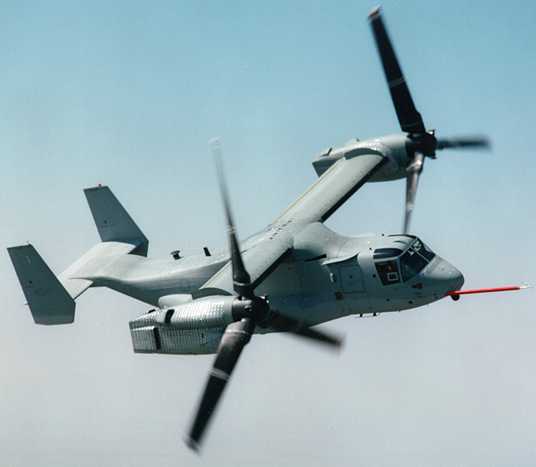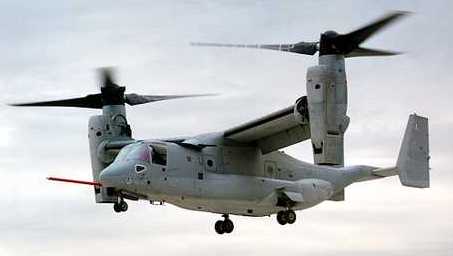V-22 Osprey (Bell Boeing)
The concept behind the Osprey is a fairly old one, going back at least to the 1940's. Have engines that can be swiveled to direct their thrust down as well as back. There are several major problems with such an arrangement. One is efficiency; the aircraft uses up major amounts of its fuel in takeoff, a problem the Osprey solves by having fuel-efficient turboshaft engines instead of turbofans, and also with an in-flight refueling capability. Another, more serious problem is what to do if an engine dies. The solution in the Osprey is rather inelegant but functional; a heavy shaft runs from one gearbox to another through the wing at the pivot point, such that one engine can power both gearboxes if necessary. This adds tons to the aircraft's weight, but it's a must for safety.
Note that due to the prop/rotor diameter, the Osprey must take off with the engines tilted to some extent.
T406 (Allison Engines)
A brute like the V-22 needs a pair of brutish engines to lift its massive airframe right off the ground. A pair of T406 turboshafts from Allison fill the bill. Specifically developed for the V-22, the engine is already spinning off derivatives like the AE2100. The real gem here is in the gearbox, which allows output to the prop/rotor, output to the opposite box (in case the opposite engine goes out), and input from the opposite box (in case this engine goes out). It also has an oiling system that allows for extended operation in a vertical position.

| Specification | T406 |
|---|---|
| Application | V-22 |
| T/O Power | 6150 shp |
| T/O SFC | "10-20% better SFC than current engines in production" |
| Cruise Power | 3584 shp |
| Cruise SFC | |
| Max pwr. pressure ratio | |
| Length (in) | 77 |
| Dia (in) | 35 |
| Weight | 971 lb dry |
 Pegasus : Propfan
Pegasus : Propfan 


